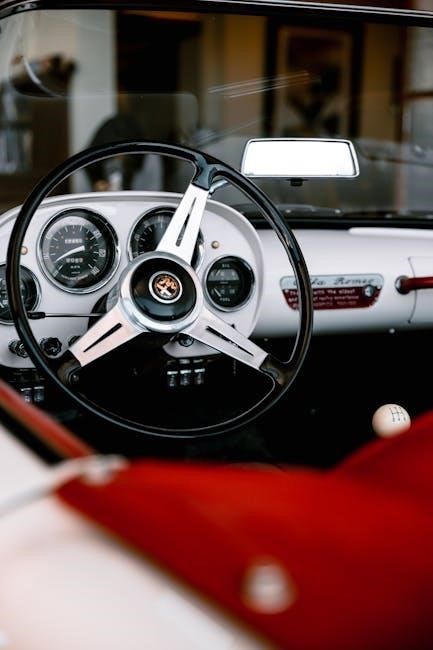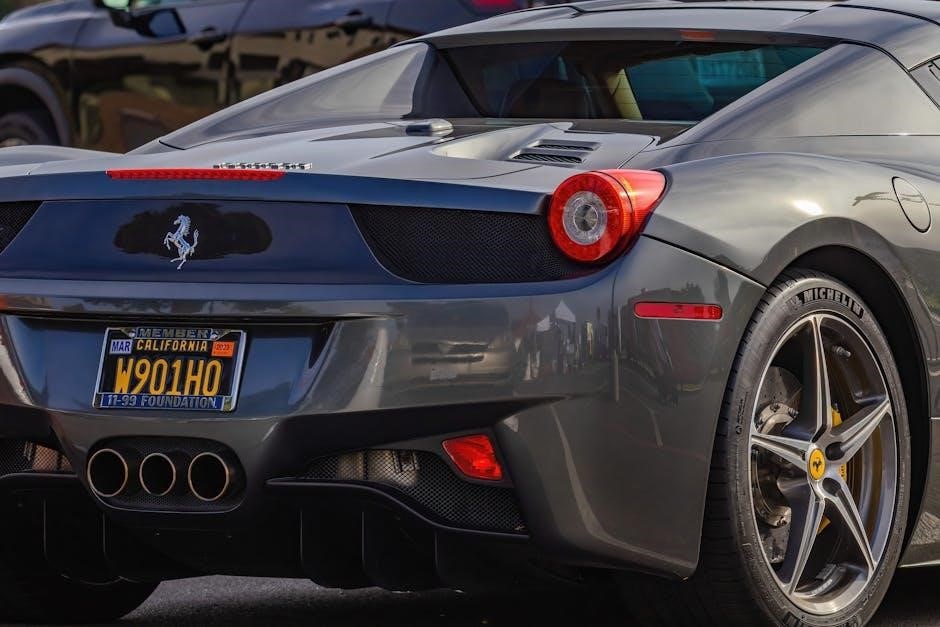Manual Ferrari California: A Rare Breed
The Ferrari California, predominantly equipped with an F1 transmission, saw a minuscule number fitted with a manual gearbox, making these examples exceedingly rare. These three-pedal versions are highly sought after by collectors and enthusiasts alike.
In an era dominated by paddle-shift technology, the manual Ferrari California stands as a defiant symbol of driving purism. The allure stems from its rarity; a handful were produced, a whisper against the roar of F1 transmissions. This scarcity elevates it beyond mere transportation, transforming it into a coveted collector’s item. For enthusiasts, the manual California represents a tangible connection to a bygone era, an engaging interaction lost in modern automatics. It’s a celebration of mechanical precision, a driving experience that demands skill, and a testament to Ferrari’s legacy of performance and driver involvement. The appeal is in the rareness.
Production Numbers and Rarity
The exact production number of manual Ferrari Californias remains shrouded in mystery, contributing to their exceptional rarity and desirability among collectors. Some say two, others five, but the real number still remains a secret.
Estimated Production Figures: Discrepancies and Accounts
Pinpointing the precise number of manual Ferrari Californias produced is a challenge, with varying accounts contributing to the ambiguity. Some sources suggest as few as two were ever made, while others estimate the figure to be closer to half a dozen or even more. These discrepancies arise from limited official documentation and anecdotal evidence gathered from collectors and Ferrari enthusiasts. Rumors persist, fueling the mystique surrounding these rare models. However, solid proof remains elusive, making it difficult to ascertain the true production figures and adding to their allure and value in the collector car market.
Documented Examples: Tracking the Known Manual Californias
Despite the uncertainty surrounding total production, dedicated enthusiasts actively track known examples of manual Ferrari Californias. Online forums and Ferrari communities serve as platforms for sharing information, including VIN numbers, ownership history, and documented sightings; Identifying these cars is crucial for establishing a more accurate understanding of their rarity. Some individuals claim to have documented three, while others suggest there are more waiting to be discovered. The pursuit of these elusive vehicles highlights the passion of collectors and their commitment to preserving automotive history. Each documented example adds a piece to the puzzle, contributing to a more complete picture.
Transmission Details
While specific transmission model information remains scarce, the manual option for the California offered a six-speed configuration. This provided drivers with a more engaging and traditional Ferrari experience.
Absence of Specific Transmission Model Information
Interestingly, publicly available documentation lacks detailed specifics regarding the precise model designation of the manual transmission used in the Ferrari California. While sources confirm the presence of a six-speed manual option, concrete details about the manufacturer or internal component specifications remain elusive. This absence of readily available information adds another layer of mystique to these rare, three-pedal Californias. The focus tends to be on the mere existence of the manual gearbox rather than the technical intricacies of the transmission itself. The general knowledge confirms that the automatic transmission was the primary option.
Manual Transmission as an Option
Despite the Ferrari California being largely associated with its automatic F1 transmission, a six-speed manual gearbox was indeed offered as an available option. This alternative, however, was chosen by a very small percentage of buyers, leading to the extreme rarity of manual California models today. The presence of a manual option catered to enthusiasts who desired a more engaging and traditional driving experience, but most purchasers favored the convenience and modern technology of the paddle-shifted F1 system, limiting the production of the manual transmission.
Why Manual Transmissions Were Offered (Briefly)
Ferrari initially offered a manual transmission in the California for homologation purposes and to satisfy initial market demand from enthusiasts. However, the F1 transmission quickly became the preferred choice.
Homologation Purposes
One of the primary reasons Ferrari offered a manual transmission in the California, albeit briefly, was for homologation. In certain markets or racing series, regulations may have required a certain number of vehicles to be produced with a manual gearbox to qualify for participation. This strategic move allowed Ferrari to meet these requirements while still focusing primarily on their F1 transmission. The exact details surrounding the homologation needs are somewhat vague. It played a role in the initial offering, but it wasn’t the sole driving force behind the decision. It was about demand, not an essential feature in the model.
Initial Market Demand
Despite Ferrari’s shift towards automated transmissions, a segment of their clientele still yearned for the engagement and connection offered by a manual gearbox. Recognizing this, Ferrari initially offered the California with a manual option to cater to these enthusiasts; While the demand wasn’t overwhelming, it was significant enough to warrant a limited production run. This decision reflected Ferrari’s willingness to acknowledge the preferences of traditionalists, who valued the puristic driving experience associated with a manual transmission. The initial market demand was not enough to keep it going, but it was worth an initial try.
End of an Era for Ferrari Manuals
The Ferrari California marked a poignant turning point, signaling the end of an era for manual transmissions within the Ferrari lineup, signifying a complete transition to automated systems.
Ferrari’s Decision to Discontinue Manual Transmissions
Ferrari’s decision to cease offering manual transmissions stemmed from several factors, including evolving market demands and the increasing performance capabilities of their automated F1 transmissions. The F1 transmission provided faster shift times and enhanced overall performance, appealing to a broader range of buyers. Furthermore, the demand for manual transmissions had dwindled significantly, making it economically unfeasible to continue production. While some enthusiasts lamented the loss of the traditional manual experience, Ferrari prioritized technological advancement and catering to the preferences of their primary customer base. This strategic shift marked a new chapter for the brand, emphasizing performance and innovation over tradition.

Value and Auction Results
Due to their extreme rarity, manual Ferrari Californias command significant premiums at auction. The value reflects their desirability among collectors seeking a unique and engaging driving experience from the Maranello brand.
High Auction Prices for Manual Californias
The scarcity of manual Ferrari Californias directly influences their value at auction, pushing prices significantly higher than their F1 counterparts. One notable example surfaced at an Artcurial auction in Paris, where it commanded a substantial premium, reflecting the immense desirability of these rare models. Collectors recognize the manual California as a unique piece of Ferrari history, representing a brief period when the marque offered a traditional driving experience in its modern grand tourer. This rarity and the associated driving engagement contribute to the elevated auction results, solidifying the manual California’s status as a highly coveted collector’s item.
Alternative to Factory Manuals
For those seeking a manual Ferrari experience, some turn to modified classics, like Touring Superleggera’s Ferrari 550-based Veloce12, offering a bespoke alternative to the rare factory manual Californias.
Modified Classics: Superleggera’s Ferrari 550
Touring Superleggera’s Ferrari 550-based Veloce12 represents a compelling alternative for enthusiasts craving a manual Ferrari experience. Since factory-built manual Californias are incredibly scarce, these modified classics offer a unique solution. The Veloce12, with its bespoke design and focus on driver engagement, captures the spirit of a bygone era.
This approach allows for a personalized touch, where the driving experience takes precedence. By extensively modifying existing platforms, companies like Touring Superleggera cater to a niche market seeking a raw, unfiltered connection with their machine, something increasingly rare in modern sports cars. It is a unique opportunity for those seeking a manual Ferrari, but unable to acquire a California.

Manual vs. F1 Transmission
The Ferrari California was primarily offered with the F1 transmission. The manual transmission provided a more engaging driving experience, appealing to purists who prefer greater control over gear selection.
F1 Transmission as the Primary Option
The F1 transmission was the primary choice for the Ferrari California. This semi-automatic system offered quick and efficient gear changes, aligning with Ferrari’s focus on performance. The F1 transmission provided a blend of driver engagement and modern technology, catering to a wider audience. While some enthusiasts yearned for the traditional manual experience, the F1 transmission was the more popular and readily available option. Its paddle-shift operation allowed for seamless transitions, enhancing the California’s overall driving dynamics. The dual-clutch design further contributed to the car’s acceleration and responsiveness. The California that had the F1 transmission allowed Ferrari to focus on ease of use.

Other Ferrari Models with Manual Transmissions
Before Ferrari discontinued manual transmissions, models like the 360 Spider offered a manual option. These cars represent a bygone era, appealing to enthusiasts who prefer a more tactile driving experience.
Ferrari 360 Spider Manual Transmission
The Ferrari 360 Spider, particularly those equipped with a six-speed manual transmission, represents a significant point in Ferrari’s history before the widespread adoption of F1 transmissions. Finding a 360 Spider with a manual gearbox today is a treat for driving enthusiasts. These models offer a purer, more engaging driving experience compared to their F1 counterparts. The manual 360 Spider stands as a testament to a time when driver involvement was prioritized. The 360 Spider equipped with a manual is a sought-after classic for collectors and drivers alike, marking a departure from the modern era.

Shift Knob Design
Owners of manual transmission Ferraris, including the California, sometimes opt for aftermarket shift knobs. These replacements allow for customization, including carbon fiber designs, to personalize the driving experience and interior aesthetics of the car.
Aftermarket Shift Knobs
For Ferrari California owners seeking a personalized touch, aftermarket shift knobs present a compelling option. These replacements cater to various tastes, from classic designs echoing Ferrari’s heritage to modern, performance-oriented aesthetics. Carbon fiber shift knobs, for example, offer a lightweight and sporty feel, complementing the car’s performance.
The availability of universal shift knobs ensures compatibility with the California’s manual transmission, although careful consideration of thread size and mounting may be necessary. These aftermarket options allow drivers to customize the tactile experience of shifting, enhancing the connection with their vehicle. Beyond aesthetics, some shift knobs are ergonomically designed to improve grip and shift feel, further elevating the driving experience.